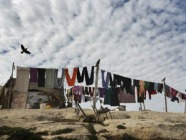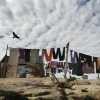 In recent weeks it has been fascinating to watch defenders of the Netanyahu government and the
settlement enterprise engaging in logical and rhetorical contortions to try to justify the Netanyahu
government's pro-settlement policies. What has emerged is simultaneously the most disingenuous and in some ways
the most honest discussion of settlements in years.
In recent weeks it has been fascinating to watch defenders of the Netanyahu government and the
settlement enterprise engaging in logical and rhetorical contortions to try to justify the Netanyahu
government's pro-settlement policies. What has emerged is simultaneously the most disingenuous and in some ways
the most honest discussion of settlements in years.
The manufactured controversy over what E-1 would mean, on the ground-a controversy that culminated this weekend
with the New York Times printing a bizarre "correction" to its
previous reporting on the issue--exemplifies the dis-ingenuousness of this discussion.
Would E-1 effectively cut the West Bank in half? Would it sever a future Palestinian capital in East Jerusalem from
its West Bank hinterland? The fact-based answer in both cases is: yes. For years, Israel has prohibited Palestinians from
taking the traditional, direct route between the northern and southern West Bank, running through East and West
Jerusalem (and of course, travel through Israel proper is impossible). Under a future peace agreement, it is
improbable that this would change. Looking at the map, the E-1 corridor offers the only real alternative for a
meaningful connection between the northern and southern West Bank. Settlement in E-1 would block off this corridor,
in effect bisecting the West Bank. It would also complete a band of settlements and related infrastructure
stretching from Ma'ale Adumim, in the east, all the way to Givat Ze'ev, in the northwest. In doing so, it would
make contiguity between the West Bank and East Jerusalem impossible, leaving the future Palestinian capital
completely isolated-in much the same way that West Berlin was isolated from West Germany (and could not function as
West Germany's capital) until German reunification.
Someone with zero familiarity with the terrain or the conflict could be forgiven for looking at the map and
suggesting that the Palestinians could "go around" or "cut through" the area. The same cannot be said for people
who know the issue. "Going around" would require travel through the Judean desert, looping around the Ma'ale Adumim
bloc and the expanded area of Jerusalem--whose outskirts would stretch nearly to Jericho--on a road that at present
doesn't exist. Jerusalem, it should be noted, is located 3,800 feet above sea level; Jericho, the lowest city on
earth, is located at 846 feet below sea level. Anyone who has driven on the winding road between Jerusalem and
Jericho understands how impossible it would be for any road through this area to create the kind of connection
between north and south necessary for a viable state. This is no doubt why, in the millennia of human existence in
this region, no such route has developed naturally.
As for cutting through E-1, it is true that creative infrastructure could create "transportational continuity"
between the northern and southern West Bank. However, the issue is not so simple:
...a sealed road, like the autobahn to Berlin pre-1989, already exists through the E-1 area for Palestinians, whose "state" under this formula would be exactly 16 yards wide. But this "solution" is dependent on the goodwill of Israel (which can close off the road anytime), and in no way compensates for the kind of territorial contiguity which is necessary for a cohesive, viable state in which the fabric of life--political and economic activity and things like education and health services--functions normally. Indeed, under these arrangements, travel from East Jerusalem to Ramallah would be possible only through the Israeli crossing at Qalandia--which already is tantamount to an international border. From the southern West Bank, it would require travel through the goat paths of Azzariya (the treacherous Wadi Naar road), to the sealed road through E-1. Moreover, neither of these Rube Goldberg-like solutions addresses the problem of cutting off East Jerusalem from the West Bank, and it is simply a fact that there will be no two-state solution to the Israeli-Palestinian conflict that doesn't establish a viable capital for the state of Palestine in East Jerusalem.
The "E-1 isn't really a big deal" controversy exemplifies the disingenuousness of the arguments offered by many
Netanyahu defenders. In this same category we find the kind of arguments employed shamelessly by Israel's
ambassador in his op-ed in last weeks New York Daily News--like saying that settlements provide
"strategic depth"--an argument that in an era of ballistic missiles doesn't pass
the laugh test--and that settlements take up only a small part of the West Bank--an argument that brazenly
misrepresents the
reality on the ground.
At the same time, many of these same defenders of Netanyahu and settlements are speaking with refreshing honesty
about the government's true intentions with respect to settlements. Ambassador Oren, for example, notes in his
article that "The West Bank cities of Bethlehem, Hebron and Jericho appear in the Bible, but Haifa in modern Israel
does not. The settlements reflect the right of a people [the Jewish people] to live in its homeland." His words
echoes those adopted by the Israeli Cabinet on December 2:
"The Jewish People has a natural, historical and legal right to his [sic] homeland and to its eternal capital,
Jerusalem; the State of Israel, as the state of the Jewish People, has a right and claim to areas, the status of
which is under dispute, in the Land of Israel."
That's it, in a nutshell. Settlements aren't about security, or about housing needs, or about anything else so
tangible or mundane. They are about taking and keeping control of the land for reasons based in
religious-nationalist ideology--ideology that is utterly incompatible with a peace agreement based on any realistic
two-state solution. Netanyahu and his supporters deserve credit for at least being honest in this respect. It would
be great if the New York Times and others would pay closer attention when they speak these truths, rather
than allowing spin and a desire for political correctness to outweigh the facts.
This article originally appeared at Open
Zion on December 17, 2012
